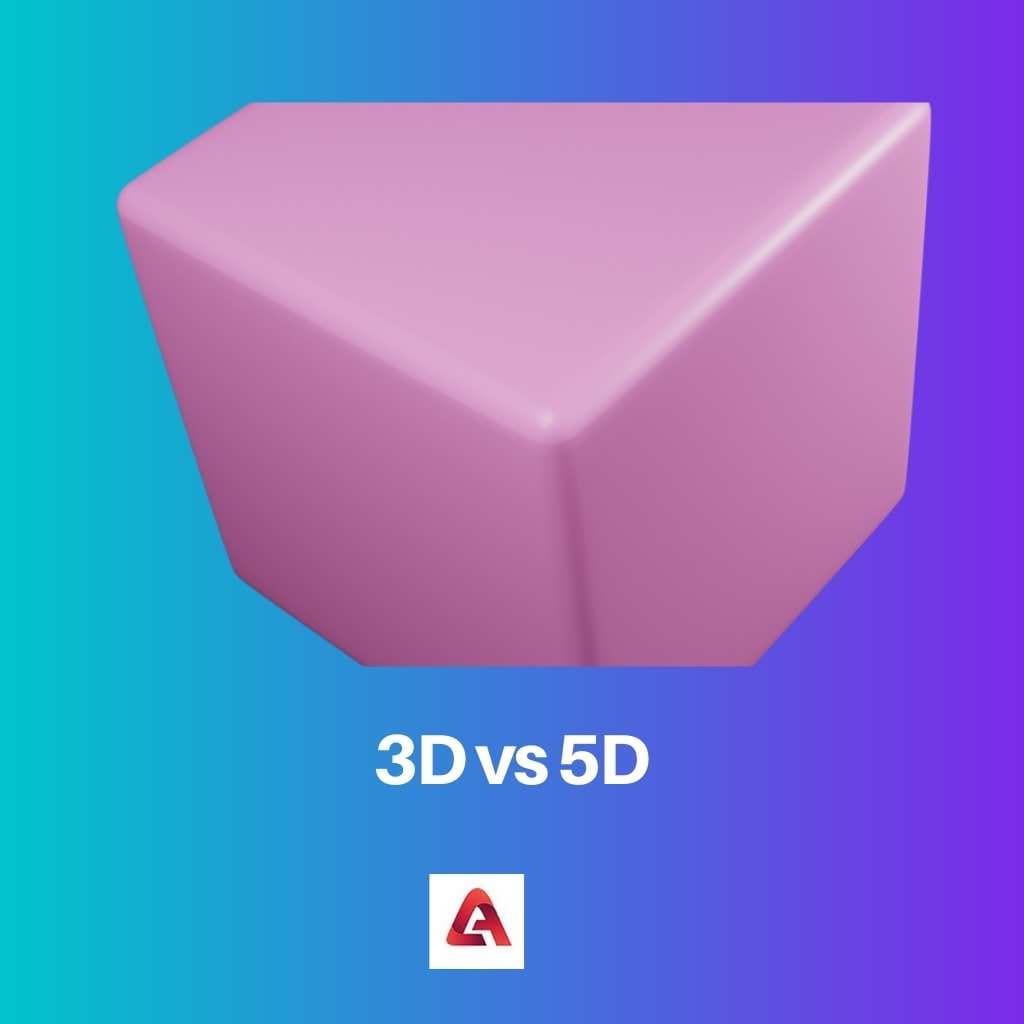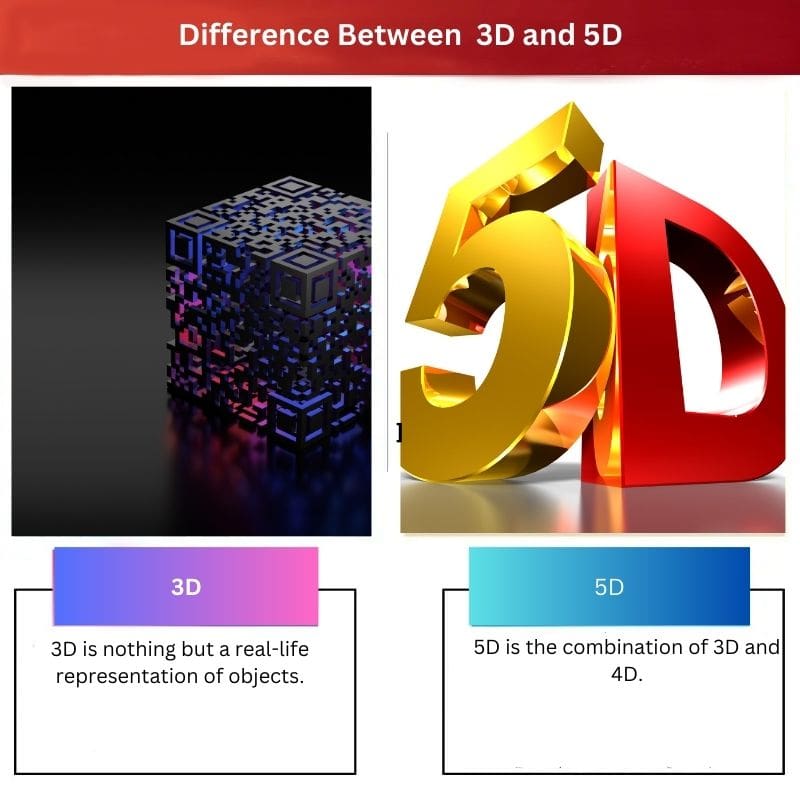Three-dimension and Five-dimension are two different concepts with many differences. Both the concepts have wide applications in this modern world.
Based on the dimensions and, other factors they are classified into many dimensions.
Key Takeaways
- 3D movies and images have three dimensions: length, width, and depth.
- 5D movies and experiences have additional features such as moving seats, wind effects, and scents.
- 5D experiences are more immersive than 3D experiences.
3D vs 5D
The difference between 3D and 5D is that 3D has three dimensions. The three dimensions are length, height, and breadth. 3D shapes are viewed with these three dimensions. On the other hand, 5D has five different dimensions. Gravity and electromagnetism are the other two properties in 5D. The 5D shapes are viewed with five dimensions.

Three-dimensional (3D) is nothing but a geometric measure. Three values are considered to measure the object. The three geometric values are called parameters.
It is also called tri-dimensional space. The dimensions are nothing but the position of the element. It is a measure of the height, width, and depth of an object.
Humans have 3D perception naturally. They can see the height, width, and depth of an object without any machines. The retina of a human being sees the object in 2D, but the brain processes it to 3D experience.
Tools like stereoscopic vision, accommodation, parallax, size familiarity, and aerial perspective are used by humans for the 3D experience.
Five-dimensional space consists of five dimensions in the space. Still, now the five-dimensional is a topic of debate. To unify four interactions, present in nature, five-dimensional theories are made.
The four interactions of nature are nothing but strong, weak, gravity, and electromagnetism. The theory called Kaluza-Klein theory proposed by Swedish scientist Oskar Klein is used as the fifth-dimensional theory.
Later, it found that the theory was partially inaccurate. New researches and theories are proposed about the five-dimensional daily.
Comparison Table
| Parameters of comparison | 3D | 5D |
|---|---|---|
| Consciousness | Ego based identity | Soul based identity |
| Total dimension | Three | Five |
| Characterization | 3D is characterized as real | 5D is characterized as abstract |
| Parameters | Length, width, height | Length, width, height, gravity, and electromagnetism |
| Geometrical bodies | Cube, cuboid | Hypersphere |
What is 3D?
Three dimensions are nothing but objects or solids consisting of three points. The three points are length, breadth, and height. Based on its dimensions, every 3D object occupies some space in this world.
The best example of 3D shapes is cube, cuboid, and cylinders. 3D technology is mixed in our daily life. 3D cinema is one popular technology that is loved by many people.
3D technology provides real-world experience in screens. 3D is primarily used in space, math, science, and cinemas now. 3D has a solid shape and space to occupy.
3D plays a vital role in the video gaming industry. Virtual Reality (VR) and Augmented Reality (AR) are works behind the 3D theory. 3D technology provides immense growth in many industries.
A 3D object has three different types of axes. It has an x-axis, y-axis, and z-axis. Every point in three-dimensional space is explained by analytical geometry in mathematics.
3D becomes an essential part of computer graphics. The 3D computer graphics are called 3D models. The 3D modeling includes animation and rendering.
3D modeling is also used in construction models. Computer-aided design (CAD) is one of the famous 3D software to create 3D models. 3D printing is one of the famous inventions.
In 3D printing, you create a solid object using the 3D printing machine. In simple three-dimensional is not a flat or thin paper. The three-dimensional denotes the box or solid objects.

What is 5D?
Five-dimensional is a complex thing to explain. It cannot be directly observable because five-dimensional is a thing rolled into a compact loop of 10^-33 centimeters.
In physics, theorize suggests that sometimes the collision of atomic particles will escape from the fourth dimension to the fifth dimension. Geometry also has five dimension shapes.
Geometry is nothing but the study of the invariant of spacetime. In simple the study of invariant’s properties is called the fifth dimension in geometry.
Five dimensions or more that consist of three different regular polytopes. They are five-simplex, five-cube, and five-orthoplex. The five-simplex belongs to a simplex family.
The five-cube belongs to the hypercube family. The five-orthoplex belongs to the cross polytope family. All have triangles, cells, cubes, squares, and tetrahedrons.
The hypersphere is a five-dimensional shape, but it is also called four-dimensional for its surface. Hypersphere has five-point from a fixed distance and a central point.
5D also has applications in cinemas. 5D technology is nothing but a combination of 4D and 3D effects. Some 5D effects are smoke, rain, lightning, flame, and bubble.
It also provides effects like water on the face and air on the face. 5D technology has immense growth in the cinema industry. In astrology, 5D is considered as soul awareness.
The fifth dimension is nothing but micro-dimension which is a tie between gravity and electromagnetism. It is not found in the fourth dimension.
Main Differences Between 3D and 5D
- 3D is nothing but a real-life representation of objects, whereas 5D is the combination of 3D and 4D.
- In mathematics, 3D has a three-dimensional axis, whereas 5D has five-dimensional vectors.
- 3D cinemas are visually improved pictures, whereas 5D cinemas have additional effects with 3D like bubbles, snow, etc.
- In ultrasound, 3D gives a three-dimensional image, whereas 5D provides five-dimensional video.
- When compared to 3D printing, 5D printing provides a curved layer.




